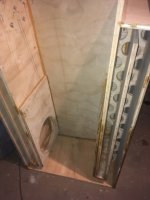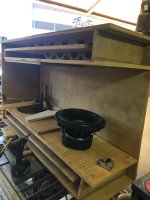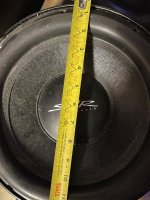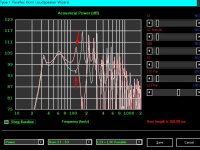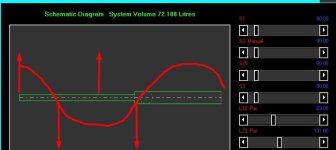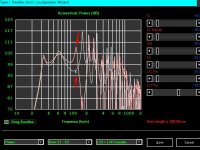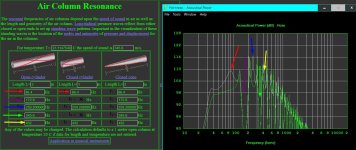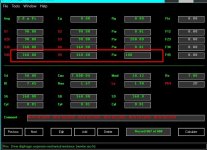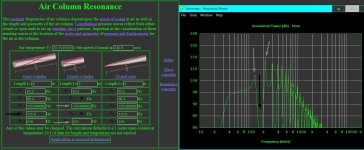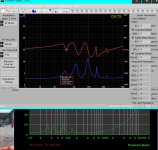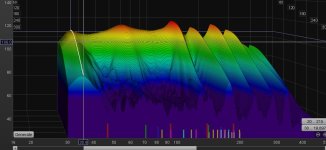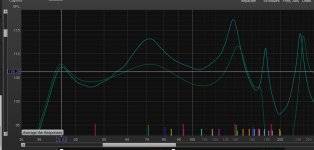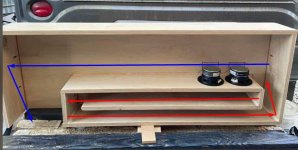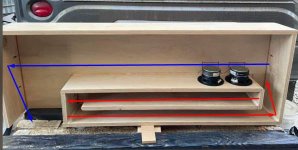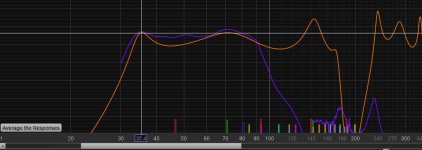Violent at that second resonace. Mediocre at Fb.Have you built or heard one?
I probably tuned too low
Attachments
I guess this is how it works? (I moved the driver 1/3 from the closed end to get rid of the ‘3/4 resonace in the red pipe, in the sim) …. So much going on in here it’s crazy.
Attachments
Last edited:
I wonder how much this kind of rabbit hole detail-stuff actually matters?
Somehow, attempting to mount the drivers in high pressure ‘end’ of the two quarter wave resonators that are only different by an octave in length and then all of this stuff kind of lines up to resonate/cancel and nothing else ?
Somehow, attempting to mount the drivers in high pressure ‘end’ of the two quarter wave resonators that are only different by an octave in length and then all of this stuff kind of lines up to resonate/cancel and nothing else ?
Attachments
I wonder how much this kind of rabbit hole detail-stuff actually matters?
Somehow, attempting to mount the drivers in high pressure ‘end’ of the two quarter wave resonators that are only different by an octave in length and then all of this stuff kind of lines up to resonate/cancel and nothing else ?
So much going on in here it’s crazy.
Boogs, did you start a threat exploring this? Maybe you should, there are a few things that can be tried. I have a lot on my plate but would really be curious to see your measurements if you do the following
Build that 1/4 wave only up to the 2nd last segment
Work out the equivalent PR for the mass in the last segment
Cap the end with that and see if the funnies poke out
I think a transmission line with a passive radiator on the end of it, just becomes a bunch of half wave resonaces based on its length (plus the Fb created by the PR)?
Last edited:
Jeeez…. Such an evil box of resonances. Loud as heck compared to the parallel Helmholtz I just made with these drivers (66verses 40 liters) .
I guess that second resonator acts like a ‘closed end pipe’ when it’s engaged? It has resonaces at 140 cm , ~46.66 cm and ~ 28 cm
I guess that second resonator acts like a ‘closed end pipe’ when it’s engaged? It has resonaces at 140 cm , ~46.66 cm and ~ 28 cm
Attachments
I sent you a manual frequency sweep through all that chaos. You might not wanna open it tomorrow 😝
@GM
@Circlomanen
@weltersys
@Patrick Bateman
How does the second pipe generate 1/4 wavelegth resonaces if it doesn’t actually have a closed end?
Unless the pipe is tuned twice the frequency of the upstream pipe then they do not complement each other at wavelengths that fit?
I don’t understand this?
Is the large cross-sectional area change and the location of the driver tap, allowing the second pipe to somehow act like a closed end resonator?
@Circlomanen
@weltersys
@Patrick Bateman
How does the second pipe generate 1/4 wavelegth resonaces if it doesn’t actually have a closed end?
Unless the pipe is tuned twice the frequency of the upstream pipe then they do not complement each other at wavelengths that fit?
I don’t understand this?
Is the large cross-sectional area change and the location of the driver tap, allowing the second pipe to somehow act like a closed end resonator?
Last edited:
If the second pipe generates a resonance that is the ‘3/4’ resonace of the whole system
What if the second pipe is some random length that doesn’t ‘fit’? How does it generate a resonace?
If you explore this in horn response, just connect a 200 cm pipe to a 100 cm pipe with four times the cross-sectional area.
Then mess with that hundred centimeter pipe and ponder what the heck is going on? (especially if you’re dumb like me!) 😝
What if the second pipe is some random length that doesn’t ‘fit’? How does it generate a resonace?
If you explore this in horn response, just connect a 200 cm pipe to a 100 cm pipe with four times the cross-sectional area.
Then mess with that hundred centimeter pipe and ponder what the heck is going on? (especially if you’re dumb like me!) 😝
Attachments
Last edited:
This is a ROAR with an alternate layout.
If you have a large sudden change in cross section area, then you get a high impedance node, just like the mouth is a high impedance node. So the 1/4 wavelength resonance sees this node as a somewhat closed end.How does the second pipe generate 1/4 wavelegth resonaces if it doesn’t actually have a closed end?
If the second pipe generates a resonance that is the ‘3/4’ resonace of the whole system
What if the second pipe is some random length that doesn’t ‘fit’? How does it generate a resonace?
If you explore this in horn response, just connect a 200 cm pipe to a 100 cm pipe with four times the cross-sectional area.
Then mess with that hundred centimeter pipe and ponder what the heck is going on? (especially if you’re dumb like me!) 😝
This
does not equal this
The pic below is a more accurate Stepped TH model of the above pic based on the actual tap points.
- Home
- Loudspeakers
- Subwoofers
- ROAR15
